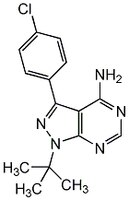529576 Sigma-AldrichInSolution™ PP2 - Calbiochem
InSolution™ PP2, 172889-27-9, is a 10 mM solution of PP2 (Cat. No. 529573) in DMSO. A potent, reversible, ATP-competitive, inhibitor of the Src family of protein tyrosine kinases.
More>> InSolution™ PP2, 172889-27-9, is a 10 mM solution of PP2 (Cat. No. 529573) in DMSO. A potent, reversible, ATP-competitive, inhibitor of the Src family of protein tyrosine kinases. Less<<Produtos recomendados
Panorama geral
| Replacement Information |
|---|
Tabela com principais espec.
| Empirical Formula |
|---|
| C₁₅H₁₆ClN₅ |
Preço e Disponibilidade
| Número de catálogo | Disponibilidade | Embalagem | Qtde/Emb. | Preço | Quantidade | |
|---|---|---|---|---|---|---|
| 529576-1MG |
|
Ampola plástica | 1 mg |
|
— |
| Description | |
|---|---|
| Catalogue Number | 529576 |
| Brand Family | Calbiochem® |
| References | |
|---|---|
| References | Hanke, J.H., et al. 1996. J. Biol. Chem. 271, 695. Selected Citations Lee, J., et al. 2009. Cell Stem Cell 5, 76. |
| Product Information | |
|---|---|
| ATP Competitive | Y |
| Form | Clear and colorless liquid |
| Formulation | A 10 mM (1 mg/331 µl) solution of PP2 (Cat. No. 529573) in DMSO. |
| Hill Formula | C₁₅H₁₆ClN₅ |
| Chemical formula | C₁₅H₁₆ClN₅ |
| Reversible | Y |
| Structure formula Image | |
| Quality Level | MQ100 |
| Physicochemical Information | |
|---|---|
| Cell permeable | N |
| Dimensions |
|---|
| Materials Information |
|---|
| Toxicological Information |
|---|
| Safety Information according to GHS |
|---|
| Product Usage Statements |
|---|
| Packaging Information | |
|---|---|
| Packaged under inert gas | Packaged under inert gas |
| Transport Information |
|---|
| Supplemental Information |
|---|
| Specifications |
|---|
| Global Trade Item Number | |
|---|---|
| Número de catálogo | GTIN |
| 529576-1MG | 07790788051211 |
Documentation
InSolution™ PP2 - Calbiochem MSDS
| Título |
|---|
InSolution™ PP2 - Calbiochem Certificados de análise
| Título | Número do lote |
|---|---|
| 529576 |
Referências
| Visão geral de referência |
|---|
| Hanke, J.H., et al. 1996. J. Biol. Chem. 271, 695. Selected Citations Lee, J., et al. 2009. Cell Stem Cell 5, 76. |
Citações
| Título | |
|---|---|
|
|
| Ficha de dados | ||||||||||||||||||||||||||||
|---|---|---|---|---|---|---|---|---|---|---|---|---|---|---|---|---|---|---|---|---|---|---|---|---|---|---|---|---|
|
Note that this data sheet is not lot-specific and is representative of the current specifications for this product. Please consult the vial label and the certificate of analysis for information on specific lots. Also note that shipping conditions may differ from storage conditions.
|







